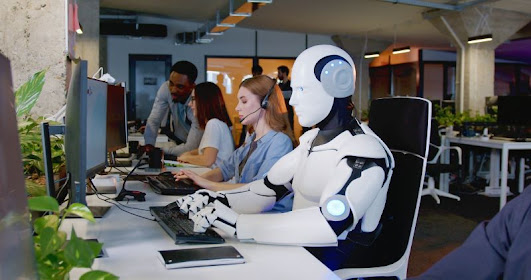cFIRST Background Checks | Best Background verification company
The concept of digital workers— AI-powered assistants that seamlessly integrate into the human workforce, is no longer science fiction. AI employees are poised to become valuable collaborators, not competitors, fundamentally reshaping how we approach tasks, responsibilities, and employee well-being.
This isn’t a dystopian scenario of AI replacing workers entirely. Despite anxieties about AI takeover, a significant portion of the workforce desires AI integration. Employees recognize the potential for AI to enhance productivity and efficiency, alleviating the current burden of feeling overwhelmed and underappreciated.
In just three years, 82% of AI adopters expect moderate to significant changes in job roles and skill sets, with 71% already observing effects on current skill sets. These AI employees have the potential to relieve human workers of tedious work, allowing them to concentrate on more critical thinking and long-term planning. However, this transformation calls for reevaluating current skill sets and building new capabilities to effectively hire and manage these digital colleagues.
Benefits of AI Employees: How They Boost Your Team
Efficiency, Speed, and Employee Satisfaction
Digital workers can handle data entry, scheduling, and report generation—tasks that devour human hours—with exceptional accuracy and lightning speed. Natural Language Processing (NLP) empowers them to understand your business lingo, workflows, and instructions to help cut down on mundane work.
A digital employee can take on tasks done in several different roles. For example, an HR digital employee can manage recruitment, onboarding, and payroll. Since human employees can focus on strategic initiatives and complex problem-solving, it leads to higher job satisfaction and lower turnover rates. Elastic Scalability
AI employees are impervious to fatigue or limited working hours. This uninterrupted workflow allows businesses to capitalize on real-time opportunities. A digital assistant trained on vast datasets can manage a surge in customer inquiries, adjusting communication styles to provide personalized support even during high-traffic periods. Unprecedented Accuracy
Digital workers are programmed for precision. Machine learning algorithms can sort through enormous amounts of data and identify patterns that might escape human perception. The digital employee can feed this intelligence into downstream systems and applications for precision across the board. It empowers human colleagues to make data-driven decisions about market fluctuations, business continuity, etc. Cost Optimization
The long-term cost savings are indisputable, even though hiring digital workers can require a sizable upfront investment. Repetitive tasks can be automated to save labor costs and avoid needing extra staff during busy times.
How to Prepare for the AI Workforce
Embrace AI Planning and Intelligent Orchestration
Make sure AI employees are dynamic and adaptable using AI planning, a subfield of AI. AI planning uses non-deterministic workflows that adjust course as needed to complete complex tasks even in the face of unforeseen circumstances. Without AI replacing workers, this empowers human-digital teams to tackle challenges with greater agility and overcome roadblocks that might hinder traditional, linear workflows. Prioritize Data Preparation and Model Training
Ensure the success of your AI employees by investing in meticulous data preparation. It involves cleaning, organizing, and labeling vast datasets to train the AI algorithms that power these digital assistants. Ongoing model training is essential. As your business needs evolve, so should your digital workers. Foster a Culture of Continuous Learning
Equip your employees with the ongoing training and support they need to adapt and thrive alongside their digital colleagues. It may involve workshops on working effectively with AI, reskilling initiatives focused on data analysis, or user interface design. Encourage a culture of experimentation where employees feel comfortable exploring new technologies. Establish Robust Governance Frameworks
Develop clear guidelines for data privacy, security, and ethical considerations in hiring and deploying digital workers. Employees need to understand how they function and the types of data they access. By prioritizing ethical concerns, you can build trust with your workforce and carry out responsible AI integration into your organization.
Finding the Perfect Digital Fit: Challenges of Hiring AI Teammates
The Evolving Skillset Conundrum
Digital workers are a new entity in the workforce. Identifying the ideal skill set for these AI-powered assistants presents a challenge. Traditional hiring metrics, focused on experience with specific software or programming languages, may not translate directly to the digital worker realm.
Organizations will need to develop new evaluation criteria that prioritize an understanding of AI principles, data analysis capabilities, and the ability to collaborate effectively with human colleagues in a hybrid work environment. The Data Dilemma
Digital workers are just as good as the data they’re built upon. Biased data can trigger biased algorithms and perpetuate discriminatory practices in areas like hiring or loan approvals. Privacy regulations and concerns about data security may limit the type and volume of data available for training purposes. Integrating an AI assistant into existing workflows necessitates access to internal data systems. Organizations must develop clear data access and usage protocols to ensure compliance with regulations and maintain employee trust. The Cost Equation
One-time capital expenditure to setup the AI worker can be significant. It is important to carefully consider these AI assistants’ acquisition, training, and integration costs compared to the anticipated return on investment. Detailed cost-benefit analyses are necessary for organizations to decide whether hiring digital workers is a financially sound choice for their particular requirements.
Conclusion
The future of work demands decisive action. Organizations that linger in the realm of ‘what ifs’ risk falling behind in a rapidly evolving landscape. The time for large-scale adoption of digital workers is now. AI replacing workers’ ingenuity is a skewed narrative. AI employees are here to augment the capabilities of human employees.
There is no denying the difficulties in preparing data, upskilling the current workforce, and determining the appropriate skill sets for digital workers. But the benefits are much greater than the difficulties. Providing employees with genuine productivity tools—tools that liberate them from the banality of repetitive tasks—is a must in today’s cutthroat talent market.
Stay updated with our latest news and blogs with cFIRST | Contact us

No comments:
Post a Comment